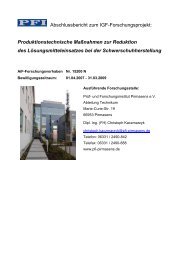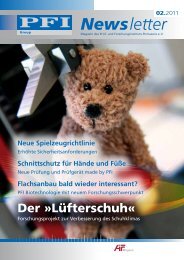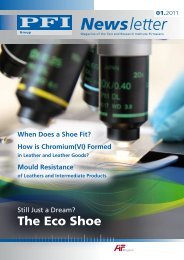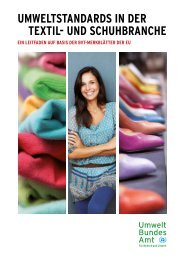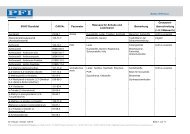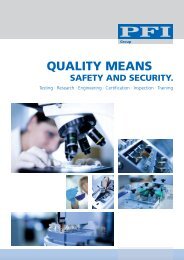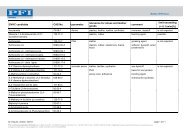News - PFI Germany Fairs and Trade Shows
News - PFI Germany Fairs and Trade Shows
News - PFI Germany Fairs and Trade Shows
Sie wollen auch ein ePaper? Erhöhen Sie die Reichweite Ihrer Titel.
YUMPU macht aus Druck-PDFs automatisch weboptimierte ePaper, die Google liebt.
The Blue Angel Emphasises a Particular Property<br />
The Blue Angel does not certify harmlessness, nor does<br />
it provide any information about which of two products<br />
bearing the label is the more eco-friendly one. Products<br />
awarded the Blue Angel are the most progressive in their<br />
respective product group as regards environmental impact<br />
from a manufacturing st<strong>and</strong>point, in the sense of: “as little<br />
as possible, as much as necessary”. In practical terms,<br />
this means that the Blue Angel is not a seal of quality for<br />
the whole product, although it takes the entire production<br />
<strong>and</strong> product life cycle into consideration, but instead<br />
st<strong>and</strong>s for a specific property of the product. The consumer<br />
must therefore pay attention to the by-line which<br />
reads, for example “The Blue Angel, because of low emissions”,<br />
“The Blue Angel, because reusable”, “The Blue<br />
Angel, because produced entirely from waste paper”,<br />
“The Blue Angel, because low in harmful substances”,<br />
<strong>and</strong> so on. A product could in fact bear more than one<br />
Blue Angel, yet the manufacturers generally limit themselves<br />
to emphasising a specific property.<br />
79 per cent of Consumers are Familiar with the<br />
Blue Angel<br />
Whereas the environmental label jury drew up just the<br />
first six basic award criteria back in 1978, the number<br />
has meanwhile increased to about 100. Today, some<br />
11,500 products from 1050 companies in 90 product<br />
categories bear the Blue Angel. The label awareness level<br />
among consumers is 79 per cent. The range of products<br />
eligible for the Blue Angel is steadily growing, <strong>and</strong> more<br />
<strong>and</strong> more new products <strong>and</strong> services are bearing the eco<br />
label. Anybody can submit suggestions of products which<br />
should qualify for the Blue Angel to the German Federal<br />
Environment Agency, including non-German companies.<br />
Institutions participating in the Blue Angel programme are<br />
the Environmental Label Jury, an independent decisionma<br />
king body with representatives of environmental <strong>and</strong><br />
consumer organisations, trades unions, industry, commerce,<br />
trades, municipalities, science, media, churches,<br />
N E W S L E T T E R<br />
Der Blaue Engel stellt eine bestimmte<br />
Eigenschaft heraus<br />
Der Blaue Engel ist aber kein Unbedenklichkeitszeichen<br />
und liefert auch keine Aussage, welches von zwei ausgezeichneten<br />
Produkten umweltverträglicher ist. Produkte<br />
mit dem Blauen Engel stellen in ihrer jeweiligen Produktgruppe<br />
eben nur ein „geringes Übel“ in puncto Umweltbelastung<br />
dar, nach dem Motto: „so wenig wie möglich,<br />
so viel wie nötig“. Konkret bedeutet das, dass der Blaue<br />
Engel kein Gütesiegel auf das Gesamtprodukt ist, sondern<br />
nur für eine bestimmte Eigenschaft des Produktes steht.<br />
Der Verbraucher muss deshalb auf den Untertitel achten,<br />
der beispielsweise lautet „Der Blaue Engel, weil emissionsarm“,<br />
„Der Blaue Engel, weil Mehrweg“, „Der Blaue<br />
Engel, weil aus 100 Prozent Altpapier“, „Der Blaue Engel,<br />
weil schadstoffarm“ und so weiter. Ein Produkt könnte<br />
tatsächlich mit mehr als einem Blauen Engel ausgezeichnet<br />
sein, doch die Hersteller beschränken sich meist auf<br />
das Herausstellen einer bestimmten Eigenschaft.<br />
79 Prozent der Verbraucher kennen den Blauen<br />
Engel<br />
Während die Jury „Umweltzeichen“ 1978 die ersten sechs<br />
Vergabegrundlagen verabschiedete, gibt es mittlerweile<br />
an die 100. Rund 11.500 Produkte von 1050 Unternehmen<br />
in 90 Produktkategorien tragen heute den Blauen<br />
Engel. Der Bekanntheitsgrad beim Verbraucher beträgt<br />
79 Prozent. Das Produktspektrum des Blauen Engels wird<br />
kontinuierlich erweitert, und somit werden immer neue<br />
Produkte und Dienstleistungen mit dem Umweltzeichen<br />
ausgezeichnet. Jeder hat die Möglichkeit, beim Umweltbundesamt<br />
auszeichnungswürdige Produkte vorzuschlagen,<br />
auch ausländische Firmen.<br />
Institutionen des Blauen Engels sind die Jury Umweltzeichen,<br />
ein unabhängiges Beschlussgremium mit Vertretern<br />
aus Umwelt- und Verbraucherverbänden, Gewerkschaften,<br />
Industrie, H<strong>and</strong>el, H<strong>and</strong>werk, Kommunen,<br />
Wissenschaft, Medien, Kirchen und Bundesländern, das<br />
Bundesministerium für Umwelt, Naturschutz und Reaktor-



